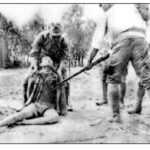
This is not to glorify or perpetuate hate, war, or violence but to gain a deeper understanding of the devastating consequences of such actions.
By studying the negative impact of these events, we can:
Promote tolerance, understanding, and peaceful resolution
let’s work towards creating a brighter, more harmonious future for all.”
Inside The Rape Of Nanking
In the six weeks during which the Japanese perpetrated the Nanking Massacre starting on December 13, 1937, an estimated 20,000 to 80,000
Chinese women were brutally raped and sexually assaulted by the invading soldiers, according to the book The Rape Of Nanking.
They sometimes went door-to-door, dragging out women and children and gang-raping them. Then, once they’d finished with their victims, they often murdered them.
Such killing wasn’t just an act of senseless barbarity, either — these men were following orders. “So that we will not have any problems on our hands,” one commander told his men, referring to any women they’ve raped, “either pay them money or kill them in some obscure place after you have finished.”
And the invaders didn’t kill their victims quickly during the Rape of Nanking. Instead, they often made these women and children suffer in the worst ways possible. Pregnant mothers were cut open, and rape victims were sodomized with bamboo sticks and bayonets until they died in agony.
Never I have heard or read such brutality,” one American missionary in Nanking, James M. McCallum, wrote in his diary. “Rape! Rape! Rape! We estimate at least 1,000 cases a night and many by day.”
On December 16, seven girls (ages ranged from 16 to 21) were taken away from the Military College,” read one disturbing report from the International Committee (a group of foreigners who established the Nanking Safety Zone to provide a place of refuge for Nanking Massacre victims). “Five returned. Each girl was raped six or seven times daily.”
One old woman 62 years old went home near Hansimen, and Japanese soldiers came at night and wanted to rape her,” read yet another chilling report from the committee. “She said she was too old. So the soldiers rammed a stick up her. But she survived to come back.”
Meanwhile, Tillman Durdin, a writer for The New York Times who was on the scene, wrote, “I drove down to the waterfront in my car. And to get to the gate, I had to just climb over masses of bodies accumulated there… The car just had to drive over these dead bodies.” Once he reached the waterfront, he witnessed the massacre of 200 men within just 10 minutes.
The extent to which Japanese officials were aware of such atrocities during the Nanking Massacre has long been a matter of debate. For one, Japanese General Iwane Matsui, commander of the forces in China, claimed that he was unaware of mass crimes but nevertheless felt morally responsible.
Ultimately, he was convicted and executed for his part in the massacre after the war ended. But in the decades since then, the legacy of the Rape of Nanking has proved to be a most contentious issue.











Leave a Reply